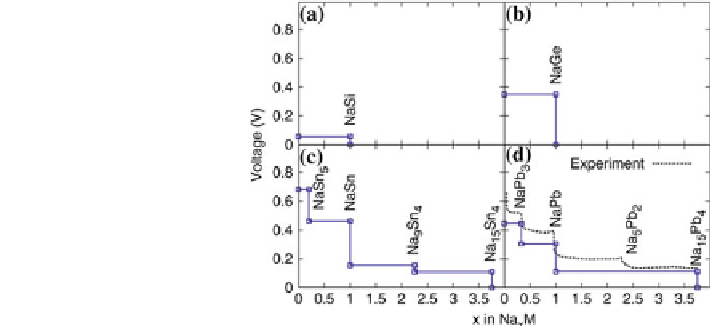Environmental Engineering Reference
In-Depth Information
Fig. 24 Na-M voltage
curves calculated using DFT
and known Na-M crystal
structures. a M-Si b M-Ge c
M-Sn, and d M-Pb [
63
]
However, when the layer spacings increase to 0.37 nm, the energy barrier for Na-
ion insertion drops markedly to 0.053 eV, indicating a feasibility of Na-ion
insertion. Therefore, it is important to seek carbon materials with appropriate layer
spacing to improve the Na insertion performance.
4.2 Alloy Materials
As shown above, the Na storage capacity of carbonaceous materials is commonly
\300 mAh g
-1
, it is difficult to further enhance their capacity due to the limited
host sites in the carbon structure. Besides, the Na intercalation potentials in car-
bonaceous materials are close to the plating potential of Na ions, which would lead
to a safety concern. Hence, it is necessary to seek alternative anode materials for
high-capacity and high-safety Na-ion batteries. Analogous to Li alloy, Na can also
alloy with some Group IVA and VA metal elements, such as Sn, Sb, Pb, and Ge
[
62
]. These alloys are estimated to deliver high reversible capacity due to their
high theoretical-specific capacities, such as 847 (Na
15
Sn
4
), 660 (Na
3
Sb), 1108
(Na
3
Ge), and 484 (Na
15
Pb
4
) mAh g
-1
, respectively. Besides, the alloying reac-
tions have higher thermodynamic potential than Na-C reactions, making them
potentially safer. Recently, Ceder et al. reported the Na-M voltage curves cal-
culated through density functional theory (DFT) for Si, Ge, Sn, and Pb (Fig.
24
)
[
63
]. The voltage curves for Si and Ge showed only one voltage plateau, indicating
the formation of a single alloy phase. On the contrary, the voltage curves for Sn
and Pb exhibited multi-voltage plateaus, corresponding to the formation of mul-
tiple alloy phases during the Na intercalation/deintercalation. These theoretical
calculations are in good agreement with the experimental data in the literatures
[
62
,
64
-
68
] Jow et al. studied the electrochemical performance of Na
15
Pb
4
alloy
for Na intercalation [
64
]. The metallurgically formed Na
15
Pb
4
gave out 86 % of
the Na storage capacity at a low rate of 50 lAcm
-3
.

Search WWH ::

Custom Search